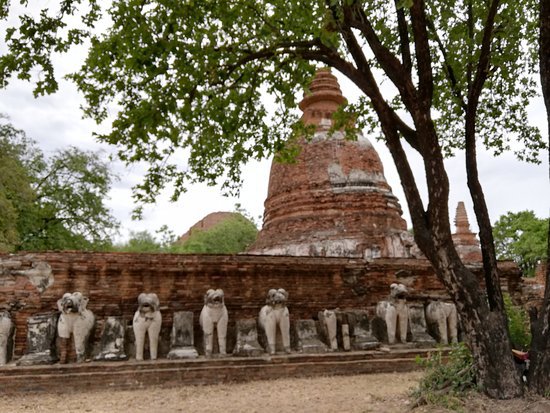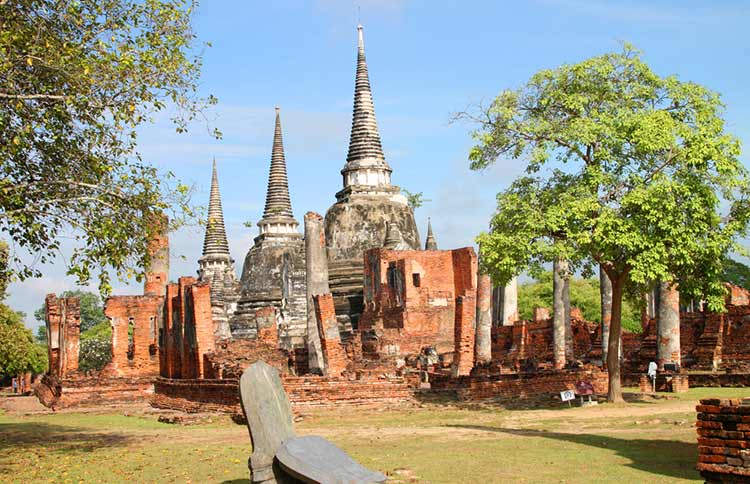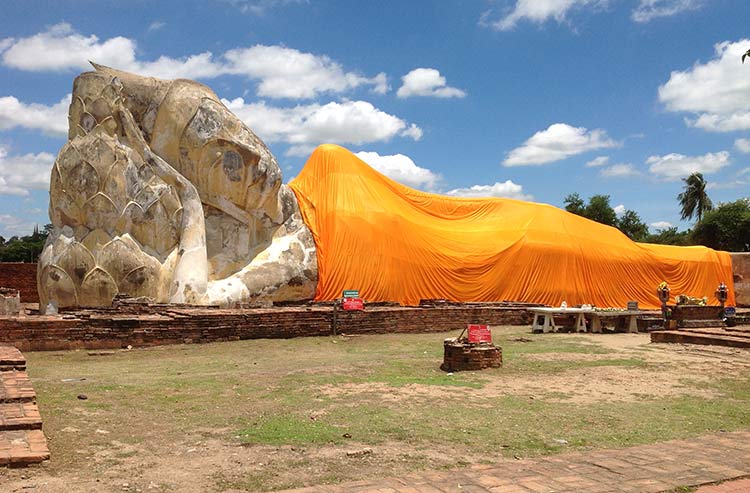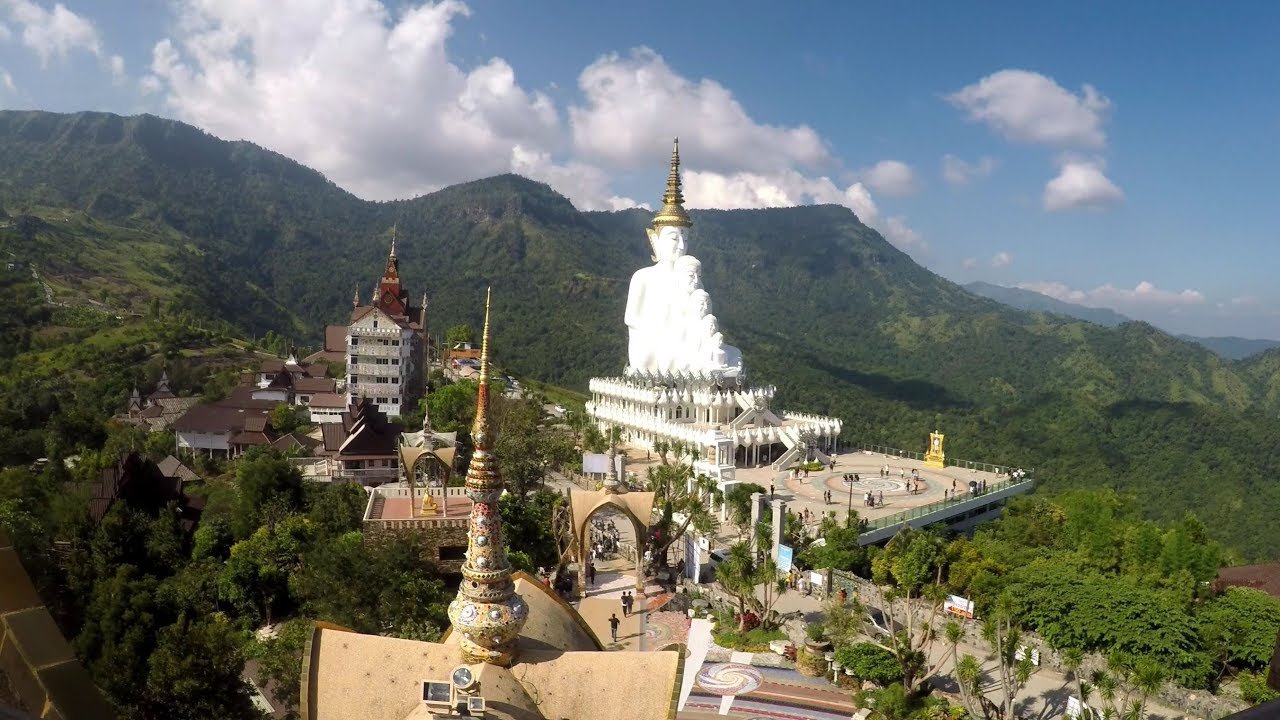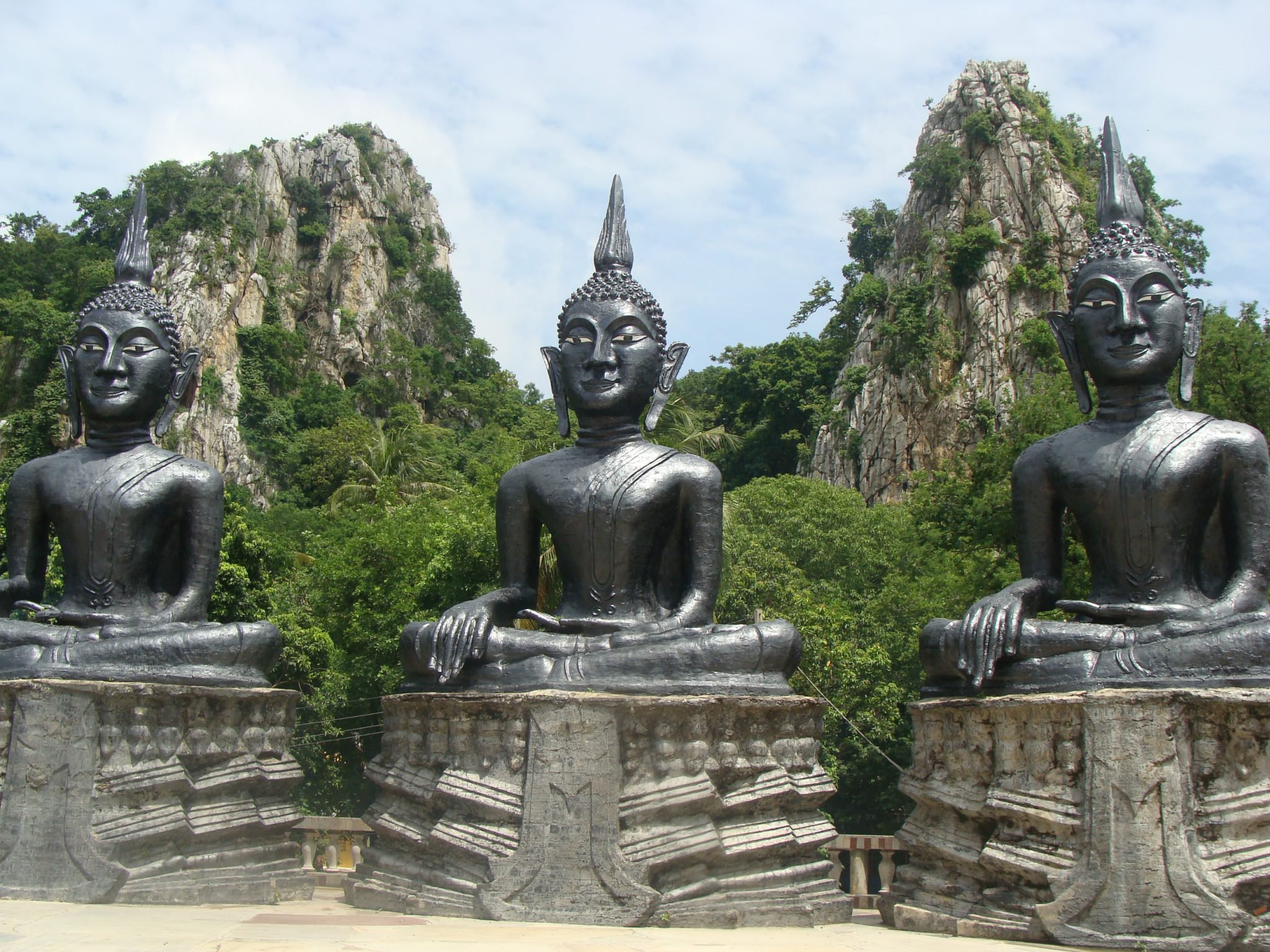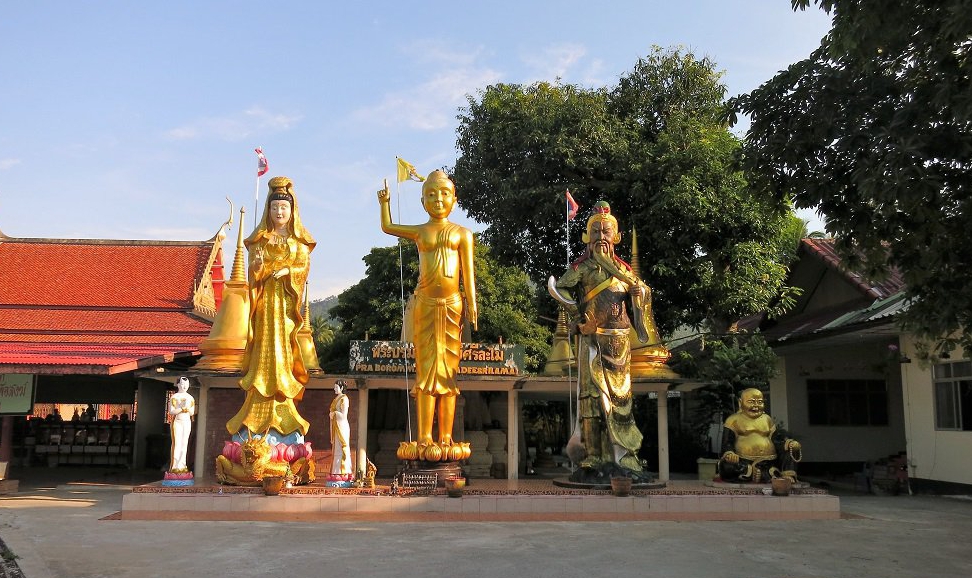Top 50 Buddhist Temples in Thailand
The main religion in Thailand is Buddhism. Theravada Buddhism is practiced by more than 95% of the population in Thailand.
There are around 30,000 Buddhist temples in Thailand. Thailand is a Buddhist country and the temples here play a very active part in everyday life. Thai’s come to them to pray to Buddha for things such as health or good fortune, they also come to make merit and speak with the monks.
The structures themselves have become such magnets for tourists to visit, not just for their spiritual and social importance, but because they are among the most beautiful and impressive structures you are ever likely to see.
Table of Contents
Ayutthaya
Ayuttaya close to Bangkok and not as crowded as the capital city makes Ayutthaya one of our favorite destinations in Thailand when it comes to visiting temples and appreciating Thai architecture.
Ayutthaya is one of the former capital cities of the Kingdom of Siam. There are so many temples both inside and outside the river boundaries that contain the naturally protected city.
There are many temples in Ayuttaya. Some are listed below
- Wat Bang Nom Kho
- Wat Chaiwatthanaram
- Wat Maheyong
- Wat Niwetthammaprawat
- Wat Phanan Choeng
- Wat Ratchaburana
- Wat Yai Chai Mongkhon
- Wat Phra Si Sanphet
- Wat Mahathat
- Wat Lokaya Sutha
Wat Bang Nom Kho
The Wat Bang Kho name is located in the district of Sena, about fifteen kilometers west of the provincial capital Ayutthaya.
Furthermore, along the Noi River, a tributary of the Chao Phraya River, there are at least two floating restaurants on the banks, offering a peaceful and pleasant view during the lunch break.
This temple is famous in this district for being the place of residence of monk Luang Po Pan so many parts of the monastery are dedicated to him.
The temple was made famous by one of Thailand’s Gaeji Ajarnhigh monks, Luang Pho Phan, who was renowned for his blowing of the sacred Diamond Armour Yantra, on the forehead of his disciples.
According to legend, many of these disciples, after death, were found to have an impression of the Yant mysteriously embedded into their skull.
The Yant was allegedly revealed to Luang Pho Phan in a dream, which led him to its discovery on a metal template hidden within a Chedi.
Luang Pho Phan was also reputed to have received the ability to make powder-based amulets of Buddha images sitting on animals from a Chee Ba Khaw, (a spirit that appeared as a firefly). These amulets are extremely sought after and expensive due to their reputed powers.
Wat Chaiwatthanaram
Wat Chaiwatthanaram was constructed in 1630 by King Prasat Thong. It was one of the grandest monuments of the Ayutthaya Kingdom.
The King built the temple as a means to gain Buddhist merit and as a memorial to his mother. Her ashes are enshrined in two square chedis flanking the ubosot on the East side of the temple.
As canon balls and canons were dug up during excavations, historians believe the temple may have been used as a fortress during the last war with Burma.
The monastery was looted and largely destroyed by the Burmese armies in 1767 after which it was deserted. During the late 1980s and early 1990s, Wat Chaiwatthanaram was restored by the Fine Arts Department.
Wat Maheyong
Wat Maheyong is located outside the city island in Hantra sub-district of Ayutthaya, which is part of the ancient area of Ayodhya, inhabited before the establishment of Ayutthaya in 1351. This ancient Ayodhya community was situated on the stretch of land formed by Khlong Hantra, Khlong Ban Bat / Kramang, and the Pa Sak River.
Following the Luang, Prasoet chronicles the monastery was built in 1438 A.D. at the start of the reign of King Borommaracha II (r. 1424-1448) of the Suphannaphum Dynasty (also called Chao Sam Phraya or King Thai Sa). Later Royal chronicles of Ayutthaya (written after the fall of Ayutthaya) changes that date and put the temple’s construction in 1424 A.D., a year generally accepted as being King Borommaracha’s throne ascendancy.
The Royal Chronicles of Ayutthaya mention that Chao Phraya Maha Sena had his stockade set up in the Hantra plains during the war with Burma in 1563-1564. His stockade was attacked by the Burmese troops of the Maha Uparat, but he was able to withstand the first attack. The second attack although, he had to give terrain and was driven with his men into the Hantra Canal (where many wounded drowned) and crossed over to the Maheyong Monastery.
Wat Niwet Thammaprawat
Wat Niwet Thammaprawat Ratchaworawihan is a Buddhist temple of the Dhammayut Order, located within the grounds of the Bang Pa-In Royal Palace in Thailand’s Phra Nakhon Si Ayutthaya Province. Founded in 1878, it is remarkable among Thai Buddhist temples in that its architecture mimics that of a European church, being built in the Gothic Revival style
Wat Ratchaburana
Wat Ratchaburana, which translates to “the temple of Royal Restoration” was built in 1424 by King Borommarachathirat II as a memorial to his two elder brothers. It is located on the historical island near Wat Mahathat.
When it was constructed it was accessible by boat as it was on the banks of a canal, that has been filled up about a century ago.
Wat Phanan Choeng
Wat Phanan Choeng is famous for its enormous seated Buddha image, considered to be one of the most beautiful in the country. According to legend tears shed from the eyes of the image just before the destruction of Ayutthaya by the Burmese in 1767.
The temple is located on the banks of the Pa Sak river opposite the South East tip of the historical island. From a riverboat, you will have great views of the monastery, that also has a boat landing.
The temple’s main attraction is its huge image of the Buddha. The brick and mortar image named Phra Chao Phanan Choeng is seated in the posture of subduing Mara, otherwise known as Calling the Earth to witness.
Wat Yai Chai Mongkhon
Wat Yai Chai Mongkhon, “the Monastery of Auspicious Victory” is located East of the historical island. A highlight of the monastery is its very large imposing prang dominating the area. Wat Yai Chai Mongkhon is still an active temple; monks live in Kuti on the grounds.
The temple was founded in the second half of the 14th century during the reign of King U Thong, the first ruler of Ayutthaya. A chedi and viharn were built, the temple was named Wat Pa Kaeo. Wat Pa Kaeo became an important time when it was made the seat of the Supreme Patriarch of the forest sect of Buddhism.
The monastery got its present name after the construction of the Chedi Chai Mongkhon in the late 16thcentury.
During the Burmese invasion of 1767, the temple was largely destroyed.
Wat Phra Si Sanphet
Wat Phra Si Sanphet, “the temple of the Buddha Si Sanphet” was the most important temple in the Ayutthaya Kingdom. Being part of the Royal Palace complex, the very large monastery with dozens of structures was used by Ayutthaya Kings only; it was a Royal temple without resident monks.
In its heydays mid 17th century the temple consisted of a raised platform supporting three very large gilded bell-shaped stupas and three gilded mondops, an enormous viharn enshrining a 16 meter tall gilded Buddha image, as well as dozens of smaller chedis and chapels.
Wat Mahathat
Wat Mahathat, “the temple of the Great Relic” was one of the most important temples in the Ayutthaya Kingdom.
Located on the historical island the large monastery features a huge central prang, a very large principal viharn and ubosot and a great number of subsidiary chedis and viharas. The upper part of its once-massive central prang has collapsed. Today only the base remains.
One of the temple’s most photographed objects is the head of a stone Buddha image entwined in the roots of a tree.
Wat Lokaya Sutha
Wat Lokaya Sutha, “the temple of the Earth” is located near the North West tip of the historical island near the old Royal Palace and Wat Phra Si Sanphet.
The highlight of the monastery is its 42 meters long Reclining Buddha image, usually draped in orange cloth. Apart from the central prang which is in fairly good condition, little more than the base of the main buildings remains today.
Little is known about the monastery’s history. Since it is located close to the Royal palace it was probably an important temple.
Bangkok
- Wat Benchamabophit (Marble Temple)
- Wat Mahatat
- Wat Arun
- Wat Suthat, with Giant Swing
- Wat Pho
- Wat Ratchanadda
- Wat Phra Kaew
- Wat Pho
- Wat Paknam Bhasicharoen
- Wat Intharavihara
- Wat Saket (Golden Mount temple)
- Wat Yannawa
Wat Benchamabophit
Wat Benchamabophit Dusitvanaram is a Buddhist temple in the Dusit district of Bangkok, Thailand. Also known as the marble temple, it is one of Bangkok’s best-known temples and a major tourist attraction. It typifies Bangkok’s ornate style of high gables, stepped-out roofs, and elaborate finials.
One of Bangkok’s most beautiful temples is the Wat Benchamabophit, also known as “the marble temple” or Wat Ben. As it is classified as a first-class Royal temple, it is also a temple of significant importance.
The official name of the temple is Wat Benchamabophit Dusitwanaram, which means “the Monastery of the fifth King near Dusit Palace”, the fifth King being King Chulalongkorn the Great (Rama V).
Wat Mahatat
Wat Mahatat is the headquarters of Thailand’s monastic order, this makes it an important place for people to study meditation and Buddhism.
Originally the temple was built to house a large relic of Buddha and is one of the oldest temples in Bangkok. Whilst you are visiting the temple you can stop to get your fortune read by one of the monks.
There is a market next to the temple every Sunday that is Bangkok’s largest amulet market, at the market all sorts of amulets, charms, and medicines are sold in the hope that you will receive good luck and ward off any evil spirits.
Wat Arun
Also known as the Temple of Dawn and sitting on the bank of the Chao Phraya River is Wat Arun, a stunning temple in a beautiful location.
This temple is unlike many others and is made up of a collection of spires that have been colorfully decorated.
The tallest spire stands at over seventy meters tall and is decorated in small pieces of Chinese porcelain and colored glass.
The central prang is climbable giving fantastic views of the winding river as well as local landmarks.
Wat Suthat, with Giant Swing
Wat Suthat is located in Bangkok and is one of the oldest temples in the city. Completed during the reign of King Rama III the temple is located quite close to the Grand Palace.
At the entrance to the temple stands a giant red swing, standing at over twenty meters tall the swing towers over everything else.
Inside the temple is a large golden Buddha statue in the seated position which is the focal point of the room. The outside walls have 156 Buddha images on them as well as four entry gates, each with intricate hand-carved designs.
Wat Pho
Wat Pho is one of the largest temples and home to the famous giant reclining Buddha. The Buddha is 46 meters long and completely covered in gold leaf, there are 108 illustrations on the Buddha’s feet which symbolize the 108 actions that helped lead Buddha to perfection. At the temple is a massage school that is considered to be the best in Thailand so after a day’s sightseeing, a massage here will help to ease away those aches.
Wat Ratchanatdaram
Wat Ratchanatdaram is located at the intersection between Ratchadamnoen Klang and Maha Chai Road, in Phra Nakhon district, Bangkok.
Meaning Temple of the Royal Niece, the temple was built to the order of King Nangklao (Rama III) for the princess granddaughter, Somanass Waddhanawathy in 1846.
The Loha Prasat, which means iron castle or iron monastery, has 37 black metal spires symbolizing the 37 virtues that are required to reach enlightenment. The 36-meter high Metal Castle consists of 3 levels, the bottom one has 24 spires, the middle one 12 and the top level has 1 spire, totaling 37 spires.
Only two other similar structures have existed in the world. It is said that during the life of the Buddha some 25 centuries ago, a huge Loha Prasat was built in India containing 1,000 rooms with a golden spire on top. Another one was built in Sri Lanka, the former Ceylon. Neither of these exists today.
Wat Phra Kaew
Wat Phra Kaew is commonly known in English as the Temple of the Emerald Buddha and officially as Wat Phra Si Rattana Satsadaram, which is regarded as the most sacred Buddhist temple in Thailand.
The Emerald Buddha housed in the temple is a potent religio-political symbol and the palladium of Thailand.
The temple is in Phra Nakhon District, the historic centre of Bangkok, within the precincts of the Grand Palace.
The main building is the central phra ubosot that houses the statue of the Emerald Buddha.
According to legend, this Buddha image originated in India where the sage Nagasena prophesized that the Emerald Buddha would bring
“prosperity and pre-eminence to each country in which it resides”.
The Emerald Buddha deified in the Wat Phra Kaew is therefore deeply revered and venerated in Thailand as the protector of the country.
Historical records date its finding to the 15th century in Chiang Rai where, after it was relocated a number of times, it was finally brought to Thailand in the 18th century.
It was enshrined in Bangkok at the Wat Phra Kaew Temple in 1782 during the reign of Phutthayotfa Chulalok, King Rama I (1782–1809).
This marked the beginning of the Chakri dynasty of Thailand, whose current sovereign is Vajiralongkorn, King Rama X.
Chiang Mai
- Wat Aranyawiwake
- Wat Chedi Liem
- Wat Chedi Luang
- Wat Chiang Man
- Wat Doi Mae Pang
- Wat Phra Singh
- Wat Phrathat Doi Suthep
- Wat Umong
- Wat Ku Tao
Wat Ku Tao
It is thought that this fabulous temple in Chiang Mai was built in 1613 to look after the ashes of Prince Saravadi, a Burmese overlord.
The name of the temple originates from the northern Thai word for melon. The pagodas at the temple are of a very unique design and were probably derived from the Chinese.
There are five spheres that make up the body of the pagoda which represent the five different Buddha’s of the present age. There are several buildings at the temple to explore including a very modern-looking vihara.
Chiang Rai
- Wat Phra That Doi Chom Thong
- Wat Phra Kaew, Chiang Rai
- Wat Phra Sing, Chiang Rai
- Wat Rong Khun
Wat Phra That Doi Chom Thong
Wat Phra That Doi Chom Thong owes its fame to its golden Chedi sheltering precious relics of the Buddha. This stupa is therefore one of the most sacred in the province because it would trace its origins, not the current structure but the relics it houses, even before the sovereign Mengrai founds this city in 1262.
Specifically, according to the Yonok chronicles mentioned by the informative panel, in the year 1483 of the Thai Buddhist era, the year 940, its relics from Sri Lanka were arranged on this hill.
Close to the Chedi, the modern Lanna Viharn extends in length and features bright red gables.
Inside, there is no red but blue on the columns directing the gaze towards the altar where sits three Buddhas, two smaller on the sides and the third, beautiful example of Lanna style, in the center.
Wat Phra Kaew
Wat Phra Kaew is a third-common-class royal temple situated in the area of 10,640 square meters on Trairat road, Wiang sub-district, Muang Chiang Rai in Chiang Rai City, Thailand.
The King of Thailand upgraded the temple to the royal temple on May 31, 1978. The temple gains historical importance as the place where the Emerald Buddha was found.
It is also one of the main centers of Buddhist education and the Sangha’s administration in northern Thailand.
Wat Phra Kaew is famous throughout Thailand as the original home of the translucent green Buddha which graces the Emerald Buddha Temple in Bangkok’s Grand Palace.
It was discovered in 1434 when a bolt of lightning hit an old Chedi. In the occasion of Princess Mother at her 90 years in 1990, Phra Yok Chiangrai, made of jade brought from Canada, a replica of that image was created to presides over at Hor Phra Yok, which was opened by Princess Kalayaniwattana on November 26, 1998.
Wat Phra Kaew is also famous as one of the royally endowed temples in this province. The abbot, Phra Dhammarachanuwat is the ecclesiastical head of all North Thailand.
Like many temples throughout Thailand, Wat Phra Kaew is the beneficiary of many donations of important religious artworks from members of its parish making merit. Arguably being the most important temple in the province, this Wat Phra Kaew has received more than its share over many centuries.
Wat Rong Khun
Sitting in the north of Thailand in Chiang Rai, Wat Rong Khun or ‘The White Temple’ is one of the most photographed and recognized temples in Thailand. The temple is white in color and has pieces of glass that have been put into the plaster to sparkle in the sun. The whiteness of the temple is a symbol of the purity of Buddha and the glass symbolizes his wisdom. A complete rebuild of the temple was started at the end of the 20th Century, with the works still going ahead today. When complete the temple will have nine separate buildings including accommodation for the working monks.
Lampang
- Wat Phra That Lampang Luang
Wat Phra That Lampang Luang
The Wat Phra That Lampang Luang is one of the most highly revered temples in Thailand. According to legend the Buddha once visited the site some 2,500 years ago and donated a hair, which is now enshrined in the temple’s large chedi.
The temple is one of the best examples of Lanna style architecture in Thailand. Its viharas that are open on all sides are typical of the early Lanna style.
Whereas some temples have been restored using modern materials and modern building techniques, the Wat Phra That Lampang Luang has been preserved in its original state.
The temple was founded in the 13th century. Its name translates to “the temple of Lampang’s Great Buddha Relic”. The architecture is a mix of Lanna and Thai Lü styles.
Lamphun
- Wat Phra That Hariphunchai
Wat Phra That Hariphunchai
In the center of Lamphun town near the Mae Kuang river is the Wat Phra That Hariphunchai, a very large temple with numerous structures dating from different periods. The name of the Wat translates to “Temple of the Sacred Hariphunchai Relic”.
Lamphun is one of Thailand’s oldest cities. It was founded in the 9th century and was the capital of the Mon Kingdom Hariphunchai.
The Lanna style Wat Phra That Hariphunchai was built on the site of an earlier 9th century Mon temple and houses one of the very few remaining examples of Mon architecture in Thailand.
According to legend, the temple was founded in 1150 by a Hariphunchai King, to enshrine a Buddha relic found in the Palace garden. It was built on the spot where the Palace of the first ruler of the Hariphunchai Kingdom, Queen Chamadevi used to be.
At the end of the 13th century, Hariphunchai was besieged by King Mengrai who brought Lamphun into the Lanna Kingdom. About the mid 15th century, the temple was renovated and expanded with a number of Lanna style structures.
Kanchanaburi
- Tiger Temple
Nakhon Si Thammarat
- Wat Phra Mahathat Woramahawihan
Pathum Thani
- Wat Phra Dhammakaya
Phitsanulok
- Wat Phra Sri Rattana Mahatat Woramahawihan
- Wat Nang Phaya
- Wat Ratchaburana, Phitsanulok
- Wat Sam Ruen
- Wat Grong Greng Rin
- Wat Laemphrathat
Phetchabun
Wat Pha Sorn Kaew
Wat Pha Sorn Kaew, also known as Wat Phra Thart Pha Kaew, is a Buddhist monastery and temple in Khao Kor, Phetchabun, in north-central Thailand, about 5 hours drive north of Bangkok.
The Wat is set on an 830m peak, a few hundred meters from the town of Kheam Son on the main highway 12, between Phitsanulok and Lom Sak.
The main pagoda and surrounding buildings are adorned with over 5 million colorful mosaic tiles and pottery items and are set in a mountain location.
5 sitting Buddha statues were already finished. There are a stained glass gazebo and a smaller pagoda in the gardens.
The main Wat exterior, gardens, and adjoining buildings are complete and open to visitors, although not all of the interior of the main temple is complete yet.
Currently, there is no well-developed tourist infrastructure surrounding the site. It is only accessible by private car or tour, as there is no public transport from the nearest towns of Lom Sak, Phetchabun or Phitsanulok.
There’s a local bus from Phitsanulok which can stop about 2km from the temple.
Saraburi
Wat Thamkrabok
Wat Thamkrabok is a Buddhist temple in Thailand, located in the Phra Phutthabat district of Saraburi Province, Thailand.
The temple was first established as a monastery in 1957 by the Buddhist nun Mian Parnchand and her two nephews, Chamroon and Charoen Parnchand, who had both ordained as monks at Wat Khlong Mao in Lopburi Province, Thailand.
Luang Por Chamroon, a former Thai policeman, was the first abbot, although Wat Thamkrabok is not officially a Buddhist temple, but is a “Samnak Song” because it follows the teachings of Luang Por Yai, a woman.
Still, the entrance claims it is a temple or Wat. The temple is majestic in its appearance, with two elephants supporting a globe marking its entrance. There are many large Buddha images on the temple grounds.
Surat Thani
- Wat Phra Yai (Big Buddha)
- Wat Khunaram (Temple of the Mummy Monk)
- Wat Lamai
- Wat Plai Laem (Guanyin temple)
Wat Phra Yai
Wat Phra Yai, known in English as the Big Buddha Temple, is a Buddhist temple on Ko Phan, a small island offshore from the northeastern area of Ko Samui, Thailand, connected to that island by a short causeway 3 kilometers (1.9 miles) north of Samui International Airport.
As its name indicates, it is home to a giant, 12-metre-high (39-foot) gold-painted Buddha statue. Since being built in 1972, it has become one of Ko Samui’s main tourist attractions and a major landmark.
Wat Khunaram
Wat Khunaram is a Buddhist temple on the island of Ko Samui in Surat Thani Province, Thailand.
It is most notable for being the shrine of “the Mummy Monk”, Luang Pho Daeng, who died in 1973 and directed that his body be put on display as a reminder of the transience of human existence.
It is located in the area between Na Muang and Hua Thanon on Thai route 4169, the main route around the island.
It is 13 km southeast of Nathon, the island’s “capital city” and main port, and 6 km west of the resort town of Lamai Beach.[
Wat Lamai
Wat Lamai is a Buddhist temple in the old part of Ban Lamai on the resort island of Ko Samui, Thailand.
Located adjacent to the main bend in Thai Route 4161, the island’s ring road, it has a museum of Buddhist artifacts and the history of Ko Samui and also has a cultural hall for public cultural events and other gatherings such as weddings and funerals.
Wat Plai Laem
Wat Plai Laem is a Buddhist temple compound on Samui’s north-east coast of Samui, featuring a striking white 18-arm image of Guanyin, the Goddess of Mercy and Compassion. Close to the Big Buddha temple, Wat Plai Laem offers visitors a view into Chinese-Thai beliefs as well as some elaborate Buddhist-themed art and architecture.
Wat Plai Laem is a living and active temple, where devotees come daily to pay homage to Guanyin and the Buddha, who is also depicted in a number of statues and murals around the temple.
This is a relatively new temple but the art techniques used in its creation are centuries old and based on ancient beliefs. Adding to its feel of tranquillity, the temple is surrounded by a lake, which is teeming with fish. Visitors who make a donation to the temple are given a bag of food to feed the fish.
Chiang Dao
- Wat Tham Pha Plong
Wat Tham Pha Plong
In the northern city of Chiang Dao and sitting halfway up the side of a mountain in a small cave is Wat Tham Pha Plong.
The temple is surrounded by forest and is a very peaceful place to visit. To get to the temple you have to walk up 500 steps, from here you can see some spectacular views of the forest below.
The monks that live in the temple allow people to stay here and carry out meditation classes, teaching, however, commences at 3.00 am. The temple was the last place that the revered monk Looang Boo Sim Buddhacaro taught at.




